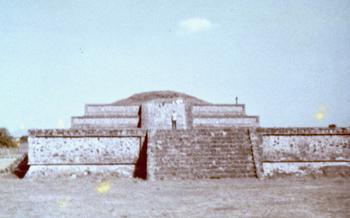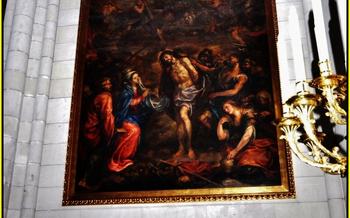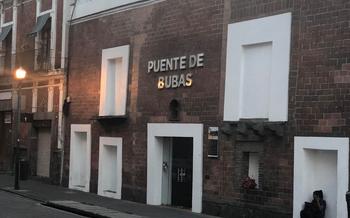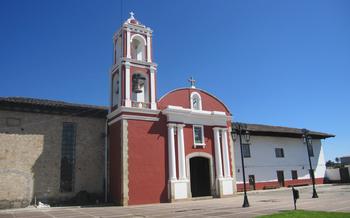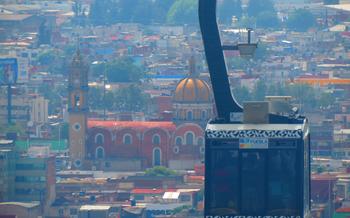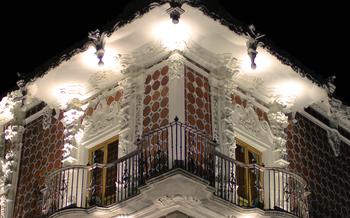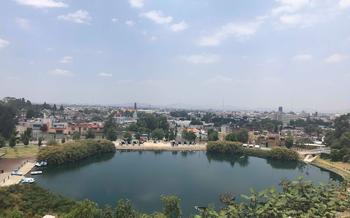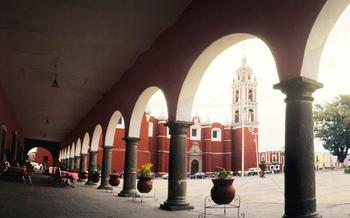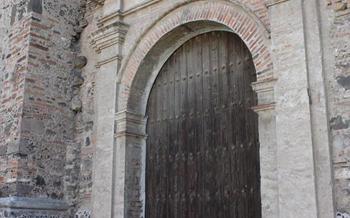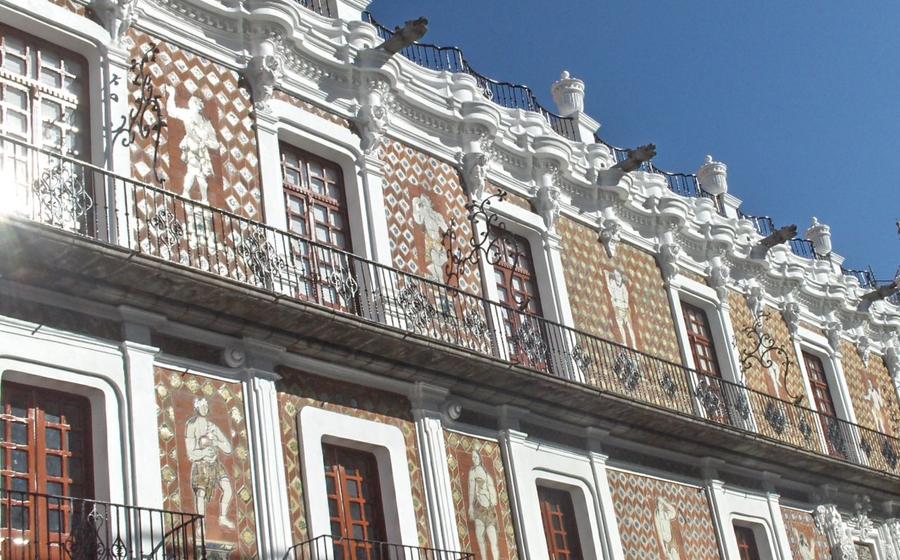
Museo Universitario Casa de los Muñecos
- Museo Universitario Casa de los Muñecos: A Cultural Gem in Puebla
- Unveiling the History of the Casa de los Muñecos
- Exploring the Fascinating Collections
- Engaging with Interactive Exhibits and Workshops
- Admire the Architectural Marvel
- Strolling Through the Vibrant Historic Center
- Immerse Yourself in Talavera Pottery Tradition
- Discover the Stories Behind the Dolls
- Planning Your Visit: Essential Information
- Exploring Beyond the Museum: Puebla's Hidden Gems
- Interactive Learning for Children
- Preservation and Conservation Efforts
- Special Events and Exhibitions
- Insider Tip: Unforgettable Souvenirs
Museo Universitario Casa de los Muñecos: A Cultural Gem in Puebla
rich cultural heritage. This magnificent museum, housed in a beautifully preserved 18th-century mansion, invites visitors to embark on a journey through time, art, and tradition. With its captivating exhibits, interactive workshops, and architectural marvels, Casa de los Muñecos offers a unique glimpse into the essence of Puebla and its people.
Must-See Exhibits and Collections:
A treasure trove of cultural artifacts awaits visitors at the Museo Universitario Casa de los Muñecos. Among its highlights are the exquisite Talavera pottery and ceramics, renowned for their vibrant colors and intricate designs. Pre-Columbian artifacts and sculptures provide a glimpse into the region's ancient civilizations, while colonial-era furniture and paintings offer a glimpse into the artistic and social life of the past. Temporary exhibitions and rotating displays keep the museum's offerings fresh and engaging, inviting visitors to return again and again.
Unveiling the History of the Casa de los Muñecos
The Casa de los Muñecos was originally built in the 16th century as the residence of a wealthy Spanish merchant named Pedro de Atlixco. The building showcased a blend of Renaissance and Baroque architectural styles, reflecting the eclectic tastes of its owner. The facade was adorned with intricate carvings and sculptures, including a series of dolls that gave the house its unique name, "Casa de los Muñecos" or "House of Dolls."
Over the centuries, the house passed through various hands, serving as a private residence, a commercial building, and even a school. In 1934, it was acquired by the Benemérita Universidad Autónoma de Puebla (BUAP) and transformed into a museum dedicated to preserving and showcasing the cultural heritage of Puebla. The museum's mission is to promote the appreciation and understanding of the city's rich history, traditions, and artistic legacy.
The transformation of the Casa de los Muñecos into a museum marked a significant milestone in Puebla's cultural landscape. It not only saved an architectural gem from deterioration but also created a platform for the display and interpretation of the city's diverse cultural treasures. The museum's collection has grown over the years, encompassing a wide range of artifacts, artworks, and historical documents that provide a comprehensive narrative of Puebla's past.
Exploring the Fascinating Collections
Museo Universitario Casa de los Muñecos houses a diverse array of captivating collections that immerse visitors in the rich cultural heritage of Puebla and Mexico. Among the highlights are the exquisite Talavera pottery and ceramics, which showcase the region's renowned craftsmanship. These vibrantly colored and intricately designed pieces, crafted from local clay and glazed with lead-free paints, tell the stories of everyday life, religious traditions, and historical events.
The museum also boasts an impressive collection of pre-Columbian artifacts and sculptures, providing a glimpse into the ancient civilizations that once thrived in the region. These captivating pieces, crafted from stone, clay, and precious metals, offer insights into the artistic, religious, and cultural practices of indigenous communities.
Furthermore, the museum showcases a collection of colonial-era furniture, paintings, and decorative arts, offering a glimpse into the opulent lifestyle of the wealthy elite during the colonial period. These pieces, adorned with intricate carvings, gold leaf, and vibrant colors, reflect the influence of European styles blended with indigenous traditions.
In addition to the permanent collections, the museum regularly hosts temporary exhibitions and rotating displays, featuring the works of contemporary artists, showcasing cutting-edge artistic trends, and delving into specific themes related to Mexican culture and history. These exhibitions offer a fresh perspective and provide visitors with an opportunity to engage with contemporary artistic expressions.
Engaging with Interactive Exhibits and Workshops
The Museo Universitario Casa de los Muñecos offers a variety of interactive exhibits and workshops that cater to visitors of all ages. Children and adults can immerse themselves in traditional crafts, multimedia presentations, storytelling sessions, and educational programs.
One highlight is the hands-on pottery workshop, where visitors can learn the basics of Talavera pottery painting and create their own unique pieces. Traditional crafts workshops demonstrate the art of Talavera tile-making, embroidery, and other local crafts.
Storytelling sessions and multimedia presentations bring to life the history and legends of Puebla, offering a deeper understanding of the city's rich cultural heritage. Educational programs and guided tours provide visitors with insights into the museum's collections and the significance of the Casa de los Muñecos.
These interactive experiences not only enhance visitors' appreciation for the museum's exhibits but also foster a sense of creativity, cultural awareness, and hands-on learning.
Admire the Architectural Marvel
The Museo Universitario Casa de los Muñecos is a architectural masterpiece that showcases the grandeur of the Baroque style. Its intricate facade, adorned with intricate carvings, statues, and relief work, sets the tone for the treasures that await inside. The central courtyard, with its graceful arches, fountains, and sculptures, offers a serene oasis amidst the bustling city. Colorful tilework and murals adorn the walls, telling stories of Puebla's rich history and culture. Don't miss the rooftop terrace, which offers panoramic views of the city, providing a breathtaking perspective of Puebla's colonial heritage.
Strolling Through the Vibrant Historic Center
The Museo Universitario Casa de los Muñecos is strategically situated in the heart of Puebla's historic center, a UNESCO World Heritage Site. Stepping out of the museum, visitors are greeted by a lively atmosphere and a treasure trove of colonial architecture. Cobblestone streets wind their way past colorful buildings, each adorned with intricate facades and wrought-iron balconies. The historic center is a living testament to Puebla's rich past, where colonial charm blends seamlessly with modern-day life.
A short walk from the museum leads to the majestic Puebla Cathedral, its twin towers dominating the cityscape. The cathedral's ornate facade, a masterpiece of Baroque architecture, is adorned with sculptures, reliefs, and intricate tilework. Just around the corner, visitors can explore the bustling Zócalo, the city's main square. Here, they can admire the 16th-century City Hall, with its elegant arcades and frescoes, and the Portal de las Flores, a lively market filled with vibrant blooms and local handicrafts.
The historic center is a haven for those seeking cultural experiences. Visitors can visit the nearby Amparo Museum, which houses a vast collection of pre-Columbian artifacts, colonial-era paintings, and contemporary art. The nearby Calle de los Dulces, or "Street of Sweets," offers a tempting array of traditional Mexican candies and pastries, while the artesanal workshops scattered throughout the district showcase the skills of local craftsmen, who create intricate Talavera pottery, textiles, and jewelry.
Strolling through the historic center is a journey through time, where visitors can immerse themselves in Puebla's rich cultural heritage. From the grand architecture to the lively markets and artisanal workshops, the historic center offers a vibrant and authentic Mexican experience.
Immerse Yourself in Talavera Pottery Tradition
Puebla is renowned for its rich history of Talavera pottery, a vibrant and intricate art form that has flourished in the region for centuries. The Museo Universitario Casa de los Muñecos serves as a showcase for this exquisite craft, housing a diverse collection of Talavera pieces that span different eras and styles.
Visitors can trace the evolution of Talavera pottery through the museum's exhibits, which showcase the distinct techniques and motifs that have characterized this art form over time. From intricate tilework to delicate tableware, each piece tells a story of Puebla's cultural heritage and the enduring legacy of its artisans.
The museum also offers workshops and demonstrations by local artisans, providing visitors with a glimpse into the creative process behind Talavera pottery. These workshops are a wonderful opportunity to learn about the traditional methods and techniques used to create these beautiful works of art. Visitors can even try their hand at painting their own Talavera tile, a unique and memorable souvenir of their visit to Puebla.
Whether you're an art enthusiast, a history buff, or simply looking for a unique cultural experience, the Museo Universitario Casa de los Muñecos is a must-visit destination in Puebla. Immerse yourself in the vibrant world of Talavera pottery and discover the stories behind these exquisite works of art.
Discover the Stories Behind the Dolls
Beyond the stunning Talavera pottery, another highlight of the Museo Universitario Casa de los Muñecos is its collection of antique dolls. These dolls hold cultural significance in Mexican traditions, representing different social classes and evolving doll-making techniques over time.
The museum's collection includes dolls from various eras, each with its unique story to tell. Visitors can admire finely crafted porcelain dolls, wooden folk art dolls, and even traditional rag dolls. These dolls offer a glimpse into the lives and customs of past generations, shedding light on the cultural diversity and creativity of Mexico.
One of the most fascinating aspects of the doll collection is how it reflects the changing roles of women in Mexican society. From dolls representing domestic duties to those depicting women in positions of power and influence, the collection provides a commentary on the evolving status of women throughout history.
By exploring the stories behind the dolls, visitors gain a deeper understanding of Mexican culture and its rich traditions. The museum's collection serves as a reminder of the importance of preserving and celebrating these traditions, ensuring they continue to be passed down to future generations.
Planning Your Visit: Essential Information
Before embarking on your journey to the Museo Universitario Casa de los Muñecos, it is essential to plan your visit to make the most of your experience. The museum is generally open from Tuesday to Sunday, with varying hours depending on the season. Admission fees are reasonable, and discounts are available for students, seniors, and groups.
Accessibility is a priority at the museum, with wheelchair ramps and elevators ensuring that everyone can explore the exhibits comfortably. Guided tours are available in English and Spanish, providing a deeper insight into the museum's history and collections. These tours are highly recommended, especially for first-time visitors.
To capture the museum's beauty, photography is permitted, but using flash is prohibited to protect the delicate exhibits. For those who wish to delve deeper into the art of photography, workshops and classes are occasionally offered, allowing visitors to hone their skills and capture stunning images of the museum's treasures.
Whether you're a seasoned traveler or a first-time visitor, the Museo Universitario Casa de los Muñecos offers a unique and enriching experience. With its captivating exhibits, interactive activities, and stunning architecture, the museum promises an unforgettable journey into the heart of Puebla's rich cultural heritage.
Exploring Beyond the Museum: Puebla's Hidden Gems
The Museo Universitario Casa to offer. Beyond the museum's walls, the city is brimming with hidden gems waiting to be discovered.
For history buffs, the Biblioteca Palafoxiana is a must-visit. Founded in 1646, this magnificent library boasts an impressive collection of rare books and manuscripts, making it one of the oldest and most important libraries in the Americas.
Art enthusiasts will delight in the Museo de Arte Religioso, showcasing a vast collection of religious art from the colonial period. The Museo Amparo, on the other hand, houses a diverse range of pre-Hispanic artifacts, colonial paintings, and contemporary art.
To experience Puebla's vibrant culinary scene, head to the Mercado El Parían. This bustling market is a feast for the senses, with vendors selling everything from traditional Mexican dishes to exotic fruits and spices.
For a unique glimpse into Puebla's past, take a walk through the Barrio de los Sapos. This charming neighborhood, known for its colorful murals and colonial architecture, was once home to the city's leatherworkers.
Puebla's surroundings are equally rich in cultural and natural attractions. Just a short drive away, you can visit the Cholula pyramid, the largest pyramid in the world by volume. The Africam Safari offers a chance to see exotic animals up close, while the Puebla Zoo is home to a variety of native Mexican species.
Whether you're interested in history, art, food, or nature, Puebla has something to offer every traveler. So venture beyond the Museo Universitario Casa de los Muñecos and explore the city's hidden gems for an unforgettable experience.
Interactive Learning for Children
Museo Universitario Casa de los Muñecos offers a delightful array of educational activities and workshops tailored specifically for young minds. Interactive exhibits are designed to spark curiosity, creativity, and a love for learning. Children can engage in hands-on activities that allow them to explore the museum's collections and cultural heritage in a fun and interactive way.
Storytelling sessions and performances bring to life the fascinating tales and legends of Puebla, captivating young imaginations. These sessions offer a unique opportunity for children to connect with the region's rich history and traditions. Family-friendly events and special programs are regularly organized, providing unforgettable experiences for both children and adults.
Through these interactive and engaging initiatives, the museum plays a crucial role in fostering a love for learning and appreciation for culture among the younger generation. A visit to Museo Universitario Casa de los Muñecos promises to be an enriching and memorable experience for families and children of all ages.
Preservation and Conservation Efforts
Museo Universitario Casa de los Muñecos plays a pivotal role in preserving and conserving Puebla's rich cultural heritage. The museum's dedicated team of conservators and curators works tirelessly to ensure that the artifacts and collections remain in pristine condition for future generations. Employing state-of-the-art techniques, they restore and maintain the integrity of the museum's treasures. The museum also collaborates with local and international institutions to share knowledge and expertise in conservation practices. Through these efforts, Museo Universitario Casa de los Muñecos stands as a guardian of Puebla's cultural legacy, ensuring that its stories and traditions continue to inspire and captivate visitors for years to come.
Special Events and Exhibitions
The Museo Universitario Casa de los Muñecos regularly hosts temporary exhibitions that showcase a diverse range of themes and artists. These exhibitions provide a platform for contemporary artists to display their works and engage with the public. Visitors can expect to encounter thought-provoking installations, captivating paintings, and innovative sculptures that challenge perspectives and spark meaningful conversations.
Beyond visual arts, the museum also organizes cultural events, concerts, and performances that celebrate Puebla's rich cultural heritage. These events often feature local musicians, dancers, and performers who bring the museum's spaces to life with their vibrant energy. Visitors can immerse themselves in traditional Mexican music, witness folkloric dance performances, and enjoy theatrical productions that showcase the city's cultural identity.
Seasonal festivals and celebrations are also a highlight at the Museo Universitario Casa de los Muñecos. During these special occasions, the museum transforms into a festive hub, adorned with colorful decorations and buzzing with activities. Visitors can participate in workshops, demonstrations, and hands-on experiences that allow them to engage with local artisans and learn about traditional crafts. These events offer a unique opportunity to immerse oneself in the vibrant spirit of Puebla's cultural heritage.
Insider Tip: Unforgettable Souvenirs
As you bid farewell to the Museo Universitario Casa de los Muñecos, don't miss the opportunity to take home a piece of Puebla's cultural heritage. The museum shop is a treasure trove of authentic Talavera pottery, intricately painted dolls, and traditional crafts. Browse the shelves and discover one-of-a-kind pieces that will serve as lasting mementos of your visit.
Venture beyond the museum to explore the local markets and artisan workshops. Here, you'll find an array of handmade goods, from colorful textiles to intricate jewelry. Engage with the friendly vendors, learn about their craft, and negotiate a fair price for your purchases. Supporting local artisans not only ensures you get unique souvenirs but also contributes to preserving Puebla's rich cultural traditions.
Remember to pack your treasures carefully to avoid damage during your journey home. Consider using bubble wrap or other protective materials to ensure your souvenirs arrive safely. By bringing a piece of Puebla back with you, you'll not only cherish the memories of your trip but also share the beauty of Mexican craftsmanship with your loved ones.
